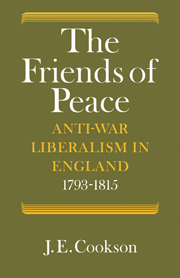Book contents
1 - THE FRIENDS OF PEACE
Published online by Cambridge University Press: 07 October 2011
Summary
Self-description is perhaps the best way to begin definition. Throughout the twenty years of war lasting from 1793 until 1815, the opponents of the war outside parliament usually called themselves the ‘Friends of Peace’. The title immediately warns us that we are not looking at a formally constituted body with an authority structure, with a declared programme and with a definite membership. ‘Friends’, indeed, well depicted the nature of the association. It was in the eighteenth century a common appellation for the groups gathered round a few leading politicians which struggled for parliamentary power and within which there was a large degree of voluntary commitment and ample scope for independent action. The same usage was found in electoral politics where a ‘popular’ candidate was sometimes supported from a common purse and by an extensive ad hoc organisation. As public opinion came into play at the national level, causes as well as individuals became the focal point of activity. The four great public issues at the end of the eighteenth century were the abolition of the slave trade, civil rights for non-Anglicans, parliamentary reform and peace, and each was seen to be supported by a body of ‘Friends’ irrespective of the societies and committees that existed. The expression, ‘Friends of Peace’, was obviously useful for declaring that a unity of opinion and sentiment was present whatever the limitations and difficulties of organisation. It evinced a common commitment, though no peace society existed and though formal organisation was carried no further than a few temporary local committees for the purposes of petitioning.
- Type
- Chapter
- Information
- The Friends of PeaceAnti-War Liberalism in England 1793–1815, pp. 1 - 29Publisher: Cambridge University PressPrint publication year: 1982
- 1
- Cited by



